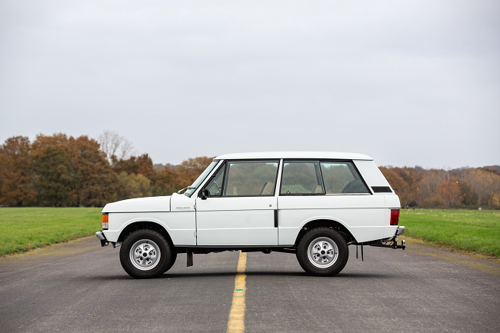RARER THAN RARE – THE SUFFIX A RANGE ROVER
17 January 2025
Autocar felt it was “even more deserving of success than the Land-Rover”. Motor Sport believed it was “quite as revolutionary as former unique events such as the arrival of the T-Ford, Volkswagen Beetle, Citroën 2 CV, Jensen FF, Issigonis Mini and other world-shaking vehicles”. In 1975, Wheels of Australia wrote: “As for breeding, the Range Rover smacks of creaseless safari suits, Swedish pipe tobacco and idyllic journeys across appalling country with Her serene at your side.”

Leaving aside the very 1970s crassness of the Wheels article, the impression is clear – the Range Rover redefined off-road driving. Looking at this 1971 Chamonix White example sold by https://keepcollection.co/, it is a reminder that Range Rover had no domestic alternative. At that time, a “large estate car” meant the Ford Zodiac Mk. IV Farnham, the Panelcraft-bodied Rover 3500, the Triumph 2.5 PI Mk.2 and the Vauxhall Victor 3300 FD. As for the well-heeled buyer who required 4WD and more comfort than a Land Rover could offer, the only other option seemed to be an imported Kaiser Jeep Wagoneer, which lacked the Range Rover’s sheer elegance.
The idea of an upmarket 4x4 Rover that would tempt US buyers from the Kaiser-Jeep and the Ford Bronco dates from the mid-1960s. Bruce McWilliams, the head of the Rover Company of North America, displayed to the company’s management his one-off, V8-powered, short-wheel base Land Rover decorated with chrome. The company dispatched its market research manager, Graham Bannock, to the States. As James Taylor quotes him in his superb book, Range Rover First Generation: The Complete Story:
The real growth was coming from people who were buying Land Rovers to tow caravans, to go on holiday, by architects and surveyors who have to go across rough country… by people who were living in suburban houses but wanted to project the kind of image that most 4×4 buyers today want to project, of being real country types.
Rover further realised that such a trend was broader than just the USA. They built the first prototype in the summer of 1966 and called the project 100-inch Station Wagon. That year, they evaluated several rival 4x4s: the Austin Gipsy, the Bronco and the Toyota Land Cruiser. They thought of using the name Land Rover Ranger until Range Rover was decided by the 18th of December 1968. Gordon Bashford and Charles Spencer ‘Spen’ King devised the coachwork, with David Bache modifying the swage lines and the front grille. Power was to be from the 3.5-litre V8 engine Rover acquired from Buick; plans for a four-cylinder version never reached fruition.
Donald Stokes, the Chair of British Leyland, wanted to unveil the Range Rover at the Geneva Motor Show, but this proved as unworkable as a plan for a Moroccan press launch. As the story goes, BL had spent so much time launching the Triumph Stag earlier that year that it had limited funds to introduce the Range Rover. So, Rover invited the media to the Meudon Hotel near Falmouth to participate in the tests staged from the 1st to the 6th of June. There was a road route, a showcase of the Range Rover’s off-road ability at the Blue Hills mine and the ground near St Agnes, and, to demonstrate its performance, drives on the RAF St Eval runway.
Sales began on the 1st of September 1970, and the Range Rover originally cost £1,998. There was soon a black market, such was the demand for the “seven-days-a-week luxury motor car for all business and domestic purposes”. One even starred alongside Tony Curtis and Roger Moore in The Morning After episode of The Persuaders!
The Keep Collection Range Rover is a Suffix A model, named after the chassis number of the very early models. This is the car Rover designed for “highways and noways” as “the most versatile motor car in the world”. And to quote one motoring writer: “It really is just as happy in the deep mire of a forest as in the King’s Road.”
With thanks to The Keep Collection for their time and permission to use the images in this blog.
